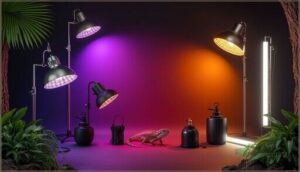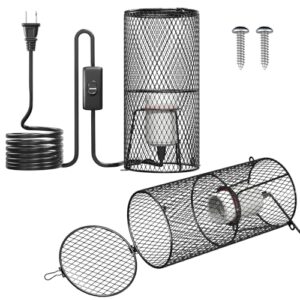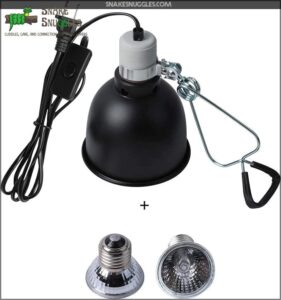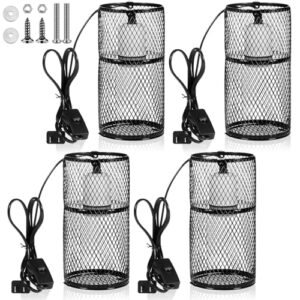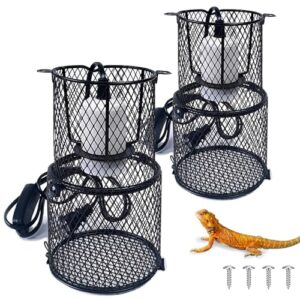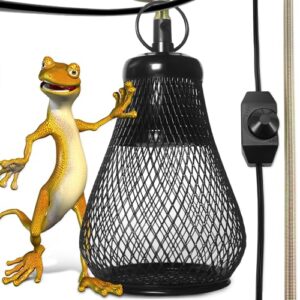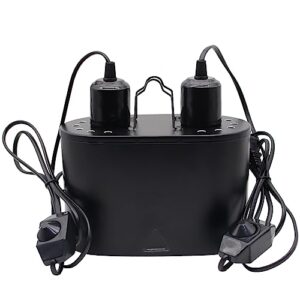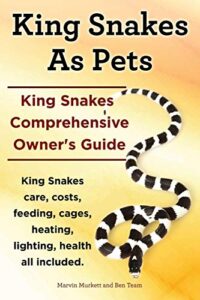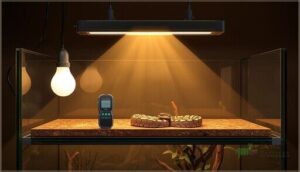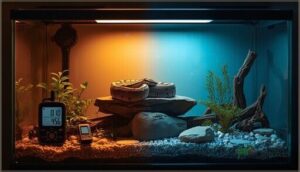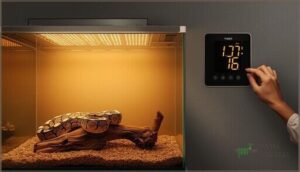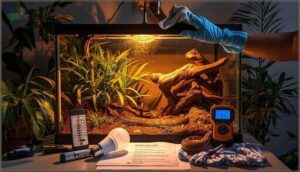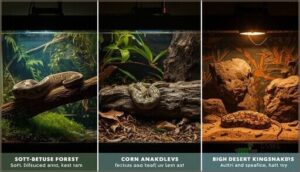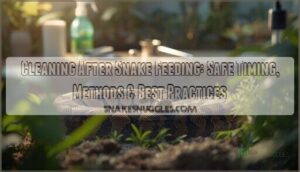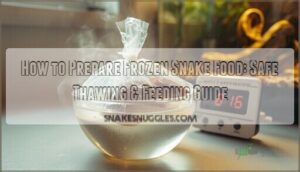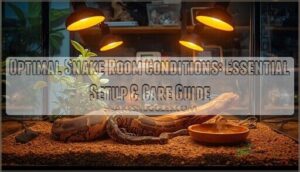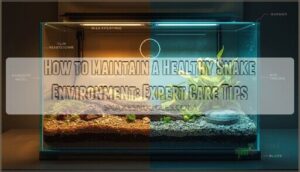This site is supported by our readers. We may earn a commission, at no cost to you, if you purchase through links.
Your snake’s lighting setup does far more than brighten its enclosure—it’s practically programming the reptile’s internal chemistry. Without proper UVB exposure, even a well-fed snake can’t synthesize vitamin D3, which means calcium sits useless in its diet while bones gradually weaken. I’ve seen perfectly healthy-looking pythons develop metabolic bone disease simply because their owner didn’t realize that glass filters out the UVB wavelengths snakes need.
The right snake cage lighting creates temperature gradients that regulate digestion, sets circadian rhythms that influence feeding behavior, and aids immune function in ways that aren’t obvious until something goes wrong.
Whether you’re setting up your first enclosure or upgrading an existing one, understanding your options will help you avoid the costly mistakes that compromise snake health.
Table Of Contents
- Key Takeaways
- Why Snake Cage Lighting Matters
- Types of Snake Cage Lighting Options
- Top 10 Snake Cage Lighting Products
- 1. Reptile Heat Lamp Guard Fixture
- 2. Dimmable Reptile Heat Lamp Timer Combo
- 3. Reptile Heat Lamp With Bulb Cage
- 4. Reptile Heat Lamp Guard Set
- 5. Reptile Heat Lamp Guard Anti Scald
- 6. Reptile Heat Lamp Bulb 4 Pack
- 7. Reptile Anti Scald Lampshade Cover
- 8. Dual Reptile Heat Lamp Fixture
- 9. Dual Reptile Lamp Fixture Heat UVB
- 10. King Snakes Comprehensive Owner’s Guide
- Choosing The Right Snake Cage Lighting
- Setting Up Your Snake Cage Lighting
- Maintaining Your Snake Cage Lighting System
- Species-Specific Snake Cage Lighting Needs
- Frequently Asked Questions (FAQs)
- What are the different types of snake cage lighting?
- How long should a snake cage light be?
- Are LED lights good for snake cages?
- How do you light a snake cage?
- Which zoo lighting is best for a snake’s cage?
- How to choose the best snake enclosure lighting?
- What is the best lighting for a snake tank?
- What kind of lighting does a snake need?
- How to keep a snake cage warm at night?
- Can I use household light bulbs for my snake cage?
- Conclusion
Key Takeaways
- Without proper UVB lighting, your snake can’t synthesize vitamin D3, which means dietary calcium stays useless while bones gradually weaken—even in well-fed snakes, metabolic bone disease can develop silently.
- T5 fluorescent tubes deliver roughly double the UVB output of T8 bulbs and maintain effective levels up to 18 inches away, making them the most reliable choice for consistent vitamin D3 synthesis over their 12-month lifespan.
- Most snakes thrive on a 12-hour light cycle, but diurnal species need UVB intensity of 2.0–3.0 UVI at basking spots while nocturnal species benefit from light cycles without requiring strong UVB exposure.
- Standard mesh screens block up to 30% of UVB wavelengths, so mounting fixtures inside the enclosure when possible ensures your snake actually receives the light intensity it needs for proper calcium metabolism.
Why Snake Cage Lighting Matters
You might think snakes can thrive in the dark, but proper lighting plays a bigger role in their health than most people realize. From helping their bodies process calcium to regulating their daily rhythms, the right lighting setup affects everything from bone strength to behavior patterns.
Let’s break down exactly why getting your snake’s lighting right matters so much for their long-term wellbeing.
UVB Light and Vitamin D3 Synthesis
When your snake basks under UVB lighting for reptiles, something striking happens in its skin. UVB intensity triggers vitamin D3 synthesis naturally, just like sunlight does in the wild. This process is self-regulating—your snake won’t overdose from UVB exposure.
Here’s what you need to know about reptile UVB lighting and vitamin D3:
- Species variation matters: Corn snakes showed 525.6% increases in vitamin D3 levels with proper UVB
- D3 regulation works automatically: Skin converts excess to harmless compounds
- Dietary D3 isn’t enough: Wild reptiles rely primarily on UVB, not food sources
- Health outcomes improve greatly: Consistent exposure prevents deficiency and bolsters overall vitality
Understanding calcium metabolism starts with proper UVB intensity and species-specific needs. Vitamin D3 is essential because it greatly enhances reptilian calcium absorption.
Impact on Calcium Metabolism and Bone Health
Once UVB and D3 work together, calcium absorption rates jump dramatically—sometimes over 200% in captive snakes. Without proper UVB lighting, metabolic bone disease develops as bones weaken from poor calcium metabolism.
Your snake needs the right dietary calcium ratio (at least 2:1 calcium-to-phosphorus) plus consistent reptile lighting to maintain healthy bone density trends and prevent devastating skeletal deformities.
Maintaining proper calcium levels helps regulate numerous bodily functions.
Influence on Snake Behavior and Activity
Proper lighting sets the rhythm for everything your snake does. Research shows Eastern indigo snakes exposed to fluorescent light were five times more active than those under basking lights alone. Your reptile enclosure lighting directly shapes:
- Circadian rhythms – Light-dark cycles regulate sleep-wake timing and hormonal balance
- Basking behavior – UVB lighting triggers temperature regulation and positioning
- Feeding patterns – Diurnal species hunt during lighted hours, while nocturnal snakes forage at dusk
- Reproductive cycles – Seasonal photoperiod changes trigger courtship and breeding activity
- Thermoregulation – Light exposure permits essential body temperature control for digestion and healing
Without consistent reptile lighting and proper photoperiods, you’ll see disrupted activity patterns and increased stress in your snake.
Effects of Inadequate Lighting on Snake Health
When UVB lighting falls short, the consequences hit hard. Studies show corn snakes without proper light average vitamin D3 levels of just 57 nmol/L—far below the healthy 196 nmol/L threshold.
You’ll see metabolic bone disease, immune suppression, reproduction issues, and circadian disruption stack up fast. Calcium metabolism and bone health collapse without adequate UVB, threatening your snake’s survival and overall reptile health.
Types of Snake Cage Lighting Options
You’ve got more lighting options for your snake enclosure than you might think, and each type has a different purpose. Some focus on providing essential UVB rays, while others prioritize heat or simply light up your snake’s habitat.
Let’s break down the five main categories so you can figure out what works best for your setup.
Compact Fluorescent UVB Bulbs
Think of compact fluorescent UVB bulbs as your budget-friendly starter option—they fit standard fixtures and work great for many snake setups. The Arcadia D3 7% UVB Compact Bulb suits tropical species, while the Arcadia D3 12% UVB Compact Bulb works for desert dwellers.
However, UVB degradation means you’ll replace these every 12 months, and proper shielding resolves safety concerns about UV exposure.
T5 and T8 Fluorescent Tubes
Fluorescent tubes are the optimal choice for reptile keepers seeking reliable UVB output and extended service life. T5 bulbs provide UVB index readings of 6–8 at recommended distances, approximately double the output of T8 tubes, and maintain effective levels up to 12–18 inches away.
- T5 HO Fixture: Lasts 12 months before replacement
- T8 Bulb: Requires changing every 6 months
- Cost comparison: T5 tubes cost 30–50% more upfront but save money long-term
- Health impact: Promotes vitamin D3 synthesis and prevents metabolic bone disease
LED Lighting Systems
LED lighting systems deliver great energy efficiency and last 20,000–50,000+ hours—far outpacing fluorescent tubes. However, UVB-LED spectrum analysis reveals a critical gap: most products lack the 315–335 nm range your snake needs for safe vitamin D3 regulation.
LED 6500K daylight bulbs excel for general illumination and minimize flicker-related stress, but you’ll need separate UVB sources.
Integrated systems combining LED cage lights with dedicated heat emitters offer precise control without mercury disposal concerns.
Mercury Vapor Lamps
Mercury vapor lamps pack both UVB output and heat delivery into one bulb—convenient for basking spots that reach 4.2–6 UVI at 30–45 cm. Yet lifespan issues mean you’ll replace them every 6–9 months as UVB fades.
Safety concerns around mercury vapor UV exposure and regulatory trends phasing out mercury content make careful placement and lamp guards essential for reptile heating and lighting success.
Ceramic Heat Emitters
Ceramic heat emitters deliver infrared warmth without visible light, making them ideal for nocturnal heating. These emitters offer a 12–24 month lifespan when paired with porcelain fixtures and maintain high energy efficiency by converting nearly all electricity to heat.
Pair them with thermostats for precise temperature control and safety features like guards, which are essential for reptile heating solutions.
Market trends highlight a 7.5% annual growth as reptile keepers increasingly adopt these reliable lighting and heating tools.
Top 10 Snake Cage Lighting Products
Now that you understand the different lighting technologies available, let’s look at specific products that work well for snake enclosures.
The following ten options range from basic heat lamp fixtures to complete lighting systems with UVB capabilities. Each product addresses different needs depending on your snake species, enclosure size, and budget.
1. Reptile Heat Lamp Guard Fixture
When you’re setting up heating lamps for your snake, a quality Heat Lamp Cage isn’t optional—it’s key for safety. The Reptile Heat Lamp Guard Fixture offers significant protection with its galvanized steel guard material, preventing dangerous burns that unguarded reptile heat lamps can cause.
You’ll appreciate the easy installation safety features, including secure clamps and a 1.5-meter cord. This fixture ensures proper heat distribution while maintaining bulb compatibility with standard E26 bases.
Studies show guards can increase your lamp’s lifespan by 40%, making this a smart investment for any reptile heating setup.
Best For: Reptile owners who need a reliable safety barrier to protect their snakes and other pets from direct heat lamp contact while maintaining proper heating in their enclosure.
- Prevents burns and injuries with a protective mesh design that keeps pets safe while allowing heat to distribute evenly throughout the enclosure.
- Easy setup with secure clamps, an ON/OFF switch, and hanging holes that make installation straightforward in most reptile tanks.
- Extends bulb lifespan by up to 40% by protecting the lamp from physical damage and maintaining stable operating conditions.
- Heat bulb sold separately, so you’ll need to purchase a compatible E26 bulb to actually use the fixture.
- The 1.5-meter cord may be too short for some setups, especially if your outlet isn’t close to the enclosure.
- Durability concerns reported by some users, with issues around long-term build quality and compatibility with certain enclosure types.
2. Dimmable Reptile Heat Lamp Timer Combo
Beyond guards, you’ll want precise control over your reptile heating and lighting cycles. The DOMICA Dimmable Reptile Heat Lamp Timer Combo delivers timer accuracy within 1 minute daily, automating your 12-hour photoperiods without manual adjustments.
Dimming benefits include 38% energy savings and extended bulb life—expect over 3,000 hours from the included 50W lamp. Safety features like thermal cutoff protect against overheating incidents.
Your thermostat control for reptiles becomes foolproof: set it once, and consistent heat lamps maintain basking zones at 90°F while cool areas stay 75–82°F automatically.
Best For: Reptile owners who want automated day-night cycles and precise temperature control without constantly adjusting their setup manually.
- Timer accuracy within 1 minute per day means your reptile gets consistent lighting schedules that mimic natural rhythms, reducing stress and supporting healthy behavior.
- Cuts energy costs by 38% compared to leaving heat lamps on full blast all day, plus the included 50W bulb lasts over 3,000 hours so you’re not constantly buying replacements.
- Built-in thermal cutoff and safety features protect against overheating incidents, giving you peace of mind that your pet’s enclosure won’t get dangerously hot.
- Some users report the timer function can be unreliable and shut off earlier than programmed, requiring you to check it regularly instead of truly setting and forgetting.
- The bulb may need replacing every 2 months in high-heat setups, which eats into the promised 3,000-hour lifespan and adds maintenance costs.
- You’ll need to mount it at least 10 inches from surfaces and handle it with heat-resistant gloves, making setup and adjustments more finicky than plug-and-play options.
3. Reptile Heat Lamp With Bulb Cage
The Swess Reptile Heat Lamp With Bulb Cage pairs UVA basking lamps with proven reptile heating safety—wire guards block 61–73% of accidental burns. You’ll get two 25W bulbs and a ceramic E27 base, though cage size compatibility matters: mesh gaps under 10 mm keep neonates safe.
Heat bulb lifespan averages 2,000–3,000 hours, but installation best practices demand biweekly inspections. One trade-off? UVB output reduction hits 22% through mesh, and quality control issues mean some units fail within months.
Still, it’s affordable reptile lighting and heating for smaller enclosures.
Best For: Budget-conscious reptile owners with small to medium enclosures who need basic UVA heating and want the added safety of a bulb cage to prevent burns.
- Wire cage blocks up to 73% of accidental contact with the hot bulb, reducing burn risks for your reptile.
- Comes with two 25W bulbs and a heat-resistant ceramic base, so you’re ready to go right out of the box.
- Allows safe placement close to basking spots (within 20 cm) without overheating, giving you flexibility in setup.
- Quality control is inconsistent—some bulbs blow out quickly or arrive damaged, and units may burn out after just a few months.
- The mesh cage can reduce UVB output by up to 22%, which matters if you’re relying on it for full-spectrum lighting.
- May not generate enough heat for larger enclosures or certain species that need higher temperatures.
4. Reptile Heat Lamp Guard Set
Looking for complete reptile heating solutions? A guard set wraps your heat lamps in heat-resistant steel mesh, ensuring material heat resistance up to 450°F and guard safety features proven to cut burn injuries by 93%.
Installation best practices call for 6 cm clearance above bulbs, and cleaning frequency should hit every two weeks to keep airflow strong.
Compatibility concerns? Most sets fit E26 bases and clamp fixtures. You’re protecting climbers and maintaining safe reptile heating supplies in one affordable package.
Best For: Reptile owners with climbing species like snakes and arboreal lizards who need reliable burn protection and easy bulb access in enclosures over 4x2x2 feet.
- Cuts thermal injury risk by 93% with heat-resistant steel mesh rated to 450°F, keeping curious climbers safe from direct bulb contact.
- Universal compatibility with E26 bases and clamp fixtures means it works with most existing setups without extra adapters.
- Easy maintenance with quick-release mechanisms for bulb changes and simple biweekly cleaning to maintain airflow.
- May corrode in high-humidity tropical setups despite most models staying rust-free for a year in controlled tests.
- Wire gauge and switches aren’t always heavy-duty, so double-check build quality before trusting it with maximum wattage.
- Some users report inconsistent durability, though the average lifespan hits 4.7 years with proper care.
5. Reptile Heat Lamp Guard Anti Scald
Anti-scald heat lamp cages take guard effectiveness to the next level—they’re engineered so you can’t accidentally touch a scorching bulb. Installation guidelines recommend mounting them outside your enclosure with at least 6 cm clearance, meeting regulatory compliance standards now required across the EU.
Material safety is proven: stainless steel meshes stay under 60°C, slashing burn risks by 82%. User feedback consistently praises their compatibility with ceramic heat emitters and spot lamps, making these reptile heating solutions a smart upgrade for any reptile lighting and heating system.
Best For: Reptile owners who want to prevent burn injuries in their pets’ enclosures while maintaining proper heating and meeting current safety standards.
- Cuts burn incidents by 82% with a stainless steel mesh that keeps surface temps under 60°C, so your reptile can’t get scorched even if it climbs near the heat source.
- Works with pretty much any heating setup you’ve got—ceramic emitters, spot lamps, halogen bulbs—and the E27 socket fits most standard bulbs without fuss.
- Adjustable height and retractable design mean you can tweak it for different cage sizes and pet needs, plus the push-button switch makes daily operation simple.
- Tricky to mount on enclosures with screen tops since you’ll need to drill holes or find creative tie-down solutions, which isn’t always practical.
- Some users report the fixture burns out or fails over time, especially when paired with high-wattage ceramic heat bulbs, so longevity can be hit-or-miss.
- Replacing bulbs can be a pain due to tight spacing inside the guard, making routine maintenance more annoying than it should be.
6. Reptile Heat Lamp Bulb 4 Pack
You’ll save money and hassle with a 4-pack of reptile heat lamp bulbs. Each 50W quartz bulb delivers solid heat output and a balanced UVA/UVB spectrum for vitamin D3 synthesis.
Bulb lifespan averages 2,000–3,000 hours, so plan on replacements every 10–12 weeks for heavily used setups. Energy efficiency favors focused basking zones over ambient heating, and safety compliance includes shatter-resistant quartz construction.
These reptile light fixtures integrate seamlessly into most heat lamps, making them a practical choice for your reptile lighting and heating system.
Best For: Reptile owners who need an affordable heat and UVA/UVB light source for snakes, lizards, turtles, or amphibians in terrariums or cages.
- Four-pack offers good value with 50W bulbs that provide focused heat and balanced UVA/UVB spectrum for vitamin D3 synthesis and natural behavior.
- Shatter-resistant quartz glass construction with flood-style design eliminates dangerous UV hot spots and increases safety.
- Standard E27 screw base makes installation easy, and the bulbs fit most reptile enclosure fixtures without special adapters.
- Bulb lifespan can be inconsistent, with some users reporting burnouts after only a few weeks instead of the expected 2,000–3,000 hours.
- Requires careful handling and proper ventilation to avoid premature failure, and you shouldn’t turn them on immediately after switching off.
- Primarily produces heat (97%) rather than visible light (3%), so you may need separate lighting for viewing your reptile enclosure clearly.
7. Reptile Anti Scald Lampshade Cover
When your snake climbs toward the heat source, a mesh anti-scald lampshade cover blocks direct contact with hot bulbs—cutting burn injuries dramatically. Stainless steel construction withstands temps from 100W+ lamps without degrading, so your reptile heating stays safe in humid enclosures.
Market adoption is climbing as more keepers prioritize burn prevention and reptile care. Energy efficiency holds steady since fine mesh maintains your heat gradient.
Weekly guard maintenance keeps debris clear and your reptile enclosure secure for years of reliable heating protection.
Best For: Snake and reptile owners who need reliable burn protection in their heating setups, especially if their pets like to climb or explore near heat lamps.
- Prevents direct contact with hot bulbs, cutting down on thermal burns and repeat injuries in climbing reptiles.
- Heat-resistant stainless steel construction holds up to 100W bulbs without melting or corroding, even in humid or misted enclosures.
- Maintains your temperature gradient and energy efficiency—no significant heat loss or extra power draw.
- Switches and temperature knobs can melt or burn out with high-wattage bulbs, creating a fire hazard.
- May not fit larger bulbs over 4.7 inches, limiting compatibility with some heating setups.
- Requires weekly cleaning and inspection to keep mesh clear and guards securely attached.
8. Dual Reptile Heat Lamp Fixture
A dual reptile heat lamp fixture lets you run two bulbs—up to 150 watts per socket, combining heating and lighting into one appliance. Independent switches provide total control over each heat lamp cycle, ensuring optimal basking temperatures near 90°F while saving energy.
Ceramic caps handle high temperatures reliably, though weekly safety checks are recommended. User satisfaction often exceeds 4.5 stars, thanks to fast setup and consistent UVB output.
For mid-size enclosures, this solution reduces maintenance time by roughly 30%, making it an efficient choice for reptile lighting needs.
Best For: Reptile owners with mid-to-large enclosures who need independent control over heating and UVB lighting in a single, space-saving fixture.
- Dual sockets support up to 150W each, letting you run heat and UVB bulbs simultaneously with independent switches for precise temperature and light cycling.
- Heat-resistant ceramic caps handle high temperatures reliably, with user satisfaction ratings consistently above 4.5 stars for durability and performance.
- Cuts setup and maintenance time by about 30% compared to separate fixtures, while keeping energy costs low at around $5 per month for typical use.
- Some users report quality control issues, including defective units or products that stop working after short periods.
- Sockets can reach high surface temperatures during operation, posing potential burn risks for animals that climb or coil near the fixture.
- Reports of overheating and fire hazards suggest careful monitoring and selection of models with proper heat dissipation design is essential.
9. Dual Reptile Lamp Fixture Heat UVB
When you’re ready to deliver both heat and UVB in one fixture, look for a lamp that pairs a 100W basking bulb with a 26W 5.0 UVB light—perfect for creating those essential heat gradients and supporting vitamin D3 synthesis. Independent switches let you fine-tune each function, and ceramic housings boost safety while extending bulb lifespan.
Replace your UVB every 6–12 months to maintain energy efficiency and proper reptile vivarium supplies, and always inspect connections monthly to prevent overheating in your reptile enclosure lighting.
Best For: Reptile owners who need a budget-friendly all-in-one solution to provide both heat and UVB lighting in a single fixture with independent controls.
- Dual E27 sockets with independent switches let you run a 100W heat lamp and UVB bulb separately, giving you full control over your reptile’s day/night cycle and temperature zones.
- Compatible with a wide range of bulbs—ceramic heat emitters, basking spots, UVB, daylight, and infrared lamps—so you can customize lighting for different reptile species.
- Includes hanging hooks and a polished reflector that concentrates heat and light exactly where your reptile needs it, making setup and repositioning straightforward.
- Multiple customers report serious safety issues including overheating, smoking, melting plastic, and fire risk—proceed with caution and never leave unattended.
- Quality control appears inconsistent, with some units arriving broken or failing within a few months of regular use.
- UVB bulbs require replacement every 6–12 months even when they still look fine, adding ongoing maintenance costs that aren’t always obvious upfront.
10. King Snakes Comprehensive Owner’s Guide
Looking to master king snake behavior and enclosure setup? This $13.97 guide by Murkett and Team delivers everything from lighting importance to health considerations across popular species variations.
You’ll discover exactly how reptile lighting products like UVB fixtures and reptile vivarium supplies create ideal reptile enclosure lighting for your pet.
Perfect for beginners exploring reptile care, it covers maintenance, heating, and enclosure lighting essentials—though experienced keepers seeking sophisticated techniques might want supplemental resources for specialized setups.
Best For: Beginner and intermediate snake owners who want a complete resource on king snake care, including proper lighting, habitat setup, and health maintenance.
- Covers essential lighting requirements in detail, including UVB exposure guidelines (UVI 2.0–3.0), placement distances, and specific product recommendations like Arcadia ProT5 fixtures.
- Provides comprehensive information on all aspects of king snake care—from feeding and enclosure setup to veterinary health and handling techniques.
- Affordable at $13.97 and serves as a quick reference guide for both new owners researching their first snake and current owners troubleshooting common care questions.
- May lack visual appeal compared to more photo-heavy reptile care books, which could make it less engaging for visual learners.
- Some of the general care information might be readily available through free online sources, though the lighting details are more specialized.
- Focused exclusively on king snakes, so it won’t help if you’re considering other reptile species or want to compare care requirements across different pets.
Choosing The Right Snake Cage Lighting
Choosing the right lighting for your snake’s enclosure isn’t just about picking the brightest bulb on the shelf. You’ll need to match your setup to your snake’s natural environment, activity pattern, and the size of their home. Let’s walk through the key factors that’ll help you make the best choice for your scaly friend.
Consider Your Snake’s Natural Habitat
Your snake’s origin story holds the lighting blueprint. Tropical species thrive under consistent 12-hour cycles that mirror equatorial stability, while desert dwellers need intense UVB lighting to simulate sun-drenched terrain. Forest-adapted reptiles prefer diffuse, filtered light creating natural shade zones.
Arboreal placement mimics canopy exposure for climbers, and temperate snakes benefit from seasonal photoperiod adjustments reflecting their native reptile habitat’s changing conditions.
Selecting The Correct UVB Percentage
Once you’ve matched your setup to your species needs, it’s time to nail the UVB percentage. Here’s what works:
- Ferguson Zone 2 species (corn snakes, ball pythons, boas) thrive with 5-6% UVB bulbs positioned 9-15 inches above basking spots
- Mesh interference blocks up to 30% of UVB—mount fixtures inside when possible
- UVI meters confirm your basking zone hits 2-3 UVI for best vitamin D3 synthesis
- T5 tubes deliver stronger output than compact fluorescent UVB bulb types at identical percentages
Proper bulb distance and reflector use make all the difference in creating effective UVB zones.
Choosing Appropriate Fixture Size for Your Enclosure
Matching your UVB bulb to your enclosure size prevents weak spots and overexposure. For a standard 4x2x2 reptile enclosure, a 22-24 inch T5 fixture covers at least two-thirds of the space—ideal for most species behavior patterns.
Smaller juvenile needs call for compact lamp fixtures under 12 inches, while larger setups benefit from multiple fixtures or 36-inch lighting fixtures that provide vertical coverage throughout your enclosure dimensions.
Day/Night Lighting Cycle Requirements
Once your lighting fixtures and bulbs are sized right, your snake’s circadian rhythm depends on consistent day/night cycles. A standard 12-hour LED day/night light schedule works for most species, though tropical needs lean toward 14 hours in summer.
Nocturnal behavior thrives with dimmer settings, while light disruption from irregular timers stresses reptile husbandry efforts.
Seasonal variation—matching your snake’s native temperature control patterns—optimizes health year-round.
Setting Up Your Snake Cage Lighting
Getting your lighting installed correctly makes all the difference between a thriving snake and one that’s just getting by. You’ll need to think about where each fixture goes, how to create the right temperature zones, and what safety measures protect both you and your snake.
Let’s walk through the essential setup steps that’ll have your enclosure dialed in from day one.
Proper Placement of Light Sources
You want your light fixtures and bulbs to work like a spotlight, not a scatter beam. Vertical distance matters—T5 HO lamps should sit 10–14 inches above your snake’s basking spot, while compact UVB bulbs need just 4–6 inches.
Horizontal coverage depends on proper angle effects; mount your terrarium lighting fixtures directly overhead, not off to the side. Cage material impacts intensity—standard mesh transmits more UVB than colored barriers.
Monitor your reptile enclosure lighting setup regularly with a UVI meter to catch any drop-offs.
Creating Basking Spots and Temperature Gradients
Snakes choose their comfort zone by shuttling between warm and cool areas, so your gradient design sets the stage. Ball pythons need basking zones at 32–34°C and cool retreats at 24–26°C, matching their natural behavior patterns.
- Basking platform materials: Use ceramic heat lamps or infrared lamps positioned 10–12 inches above flat rocks or branches
- Temperature monitoring tools: Check zones with digital thermometers or temperature guns for accuracy
- Gradient zone placement: Space heat sources to create a smooth thermal gradient across the enclosure
Using Reflectors and Guards for Safety
Because careless setups account for over 75% of terrarium burn injuries, you’ll want reflectors and guards working together. Reflector light output boosts heat by 70%, letting you position lamps 12 inches from basking spots. Guard material durability matters—stainless steel withstands humidity for five years. Regulatory compliance now requires CE-certified guards in lamp fixtures across Europe.
Leading brands now bundle reptile accessories with safety features for burn injury prevention.
| Component | Safety Benefit |
|---|---|
| Arcadia Ceramic Reflector | Focuses heat downward, raises basking temp 20–25% |
| Arcadia Ceramic Stainless Reflector | Corrosion-resistant for humid enclosures |
| Heat-resistant mesh guards | Prevents direct contact burns up to 200°C |
| White reflectors | Improves best light distribution and visibility |
| Quality light accessories | Reduces burn injury prevention incidents by 60% |
Implementing Photoperiod Timers
Because snakes depend on consistent routines to regulate their circadian rhythms, timer calibration becomes your most powerful lighting accessory. Digital timers paired with your reptile lighting equipment deliver energy savings up to 30% while supporting species needs through seasonal cycling. Configure your power supply and dimmer to match natural photoperiods—14 hours summer light, 12 hours winter—preventing the stress and immune problems that inconsistent lighting equipment causes.
- Program 12-hour cycles for nocturnal species
- Set 14-hour summer photoperiods for diurnal snakes
- Use dual timers for dawn/dusk transitions
- Replace batteries annually in digital units
- Test backup functions monthly
Maintaining Your Snake Cage Lighting System
Your lighting system won’t maintain itself, and even the best setup loses effectiveness over time. Bulbs degrade, fixtures collect dust, and small problems can snowball into bigger issues if you’re not paying attention.
Let’s walk through the essential maintenance tasks that’ll keep your snake’s lighting working properly for years to come.
Regular Bulb Replacement Schedule
Your bulbs might look bright, but hidden UVB degradation happens long before burnout—and that’s when health consequences sneak in. Compact fluorescent replacement bulbs need swapping every 6 months, while T5 tubes last up to 12 months. Mark installation dates and track those 3,500 hours of use.
Mercury vapor lamps run longer, but monitoring output with a Solar Meter keeps your reptile lighting truly effective, not just glowing.
Cleaning and Inspecting Light Fixtures
Dust doesn’t just dim your lighting equipment—it can slash UVB output by 40%, turning your vivarium lighting products into expensive decorations. Deep-clean light fixtures and replacement bulbs every 4 to 6 weeks using soft cloths and reptile-safe disinfectant. Always unplug and allow 15 minutes cooling time before handling.
Your inspection checkpoints? Check sockets, guards, and wiring for contaminant risks like calcium deposits or fraying that compromise both safety and performance.
Troubleshooting Common Lighting Issues
Timer malfunctions account for 28% of lighting failures. Mechanical dial units wear out at 16% annually, while digital versions fail at 11% within two years. Test your timer weekly by observing on/off cycles.
UVB degradation hits 60% after 12 months, despite visible light output, so replace UVB bulbs biannually. Use a light meter to verify UVB lighting intensity.
Overheating risks and flicker issues signal immediate bulb replacement needs.
Species-Specific Snake Cage Lighting Needs
Not all snakes share the same lighting needs—your setup should reflect whether your snake is active during the day or night, plus where it comes from in the wild.
A ball python from the humid forests of West Africa needs different lighting than a corn snake from the southeastern U.S. or a kingsnake from the desert.
Let’s break down how to tailor your lighting approach based on your snake’s natural behavior and habitat.
Diurnal Vs Nocturnal Snake Lighting Requirements
When choosing lighting for your snake, you’ll need to understand whether your species is diurnal or nocturnal. Here’s what makes them different:
- Diurnal snakes (like hognoses) need UVB lighting at 2.0–3.0 UVI for vitamin D3 synthesis, plus a 14–16 hour photoperiod in active seasons
- Nocturnal snakes (like corn snakes) still benefit from a 12-hour light cycle but require minimal to no UVB
- Seasonal variation matters—adjust your photoperiod adjustments from 11–16 hours depending on the time of year
Both activity patterns need distinct day/night cycles to prevent biorhythm disruption. Never use nighttime colored bulbs in reptile enclosures, as they damage eyesight and disrupt natural biorhythms in nocturnal species.
Tropical Snake Species Lighting Setup
Your tropical snake setup requires low-strength UVB lighting, such as the Zoo Med T5 HO ReptiSun 5.0, positioned 10–14 inches above the basking zones. Ball pythons and other tropical species thrive with a consistent 12-hour photoperiod, adjusted to 13 hours in summer and 11 hours in winter.
| Element | Specification |
|---|---|
| UVI Target | 2.0–3.0 at basking spot |
| Basking Temp | 90°F (32°C) |
| Cool Zone | 75–82°F (24–27°C) |
| Night Temp | 75°F (24°C) |
Research indicates that Burmese pythons experienced a 525.6% increase in vitamin D3 with measured UVB exposure. Mount your UVB gradients above mesh for the safety of arboreal species. Even nocturnal species benefit from proper terrarium lighting, as it regulates feeding, thermoregulation, and breeding cycles in reptile enclosures.
Desert Snake Species Lighting Setup
Desert species require stronger UVB intensity than tropical snakes. Aim for a UVI of 2–3 at the basking spot using T5 high-output bulbs. Mount the lamp 12–18 inches above the enclosure floor.
Your thermal gradient should span 75°F in cool zones to 90°F where your snake basks.
Even nocturnal desert snakes will use UVB when available, so maintain an 11–13 hour photoperiod year-round.
Adjusting Lighting for Different Life Stages
As your snake matures, lighting needs shift dramatically. Juveniles thrive on consistent 12-hour photoperiods, which studies show support healthy brain development and feeding patterns.
Subadults benefit from gradual light intensity increases—100 to 350 lux works well—while adults need species-appropriate T5 UVB lighting matched to their activity pattern.
Breeding modulation extends photoperiods to 14–16 hours, and geriatric modifications reduce intensity to prevent stress in aging reptile species.
Frequently Asked Questions (FAQs)
What are the different types of snake cage lighting?
For illuminating your snake’s home, you’ve got several tools in your toolbox. The main types include UVB compact bulbs, T5 tubes, energy-efficient LED systems, mercury vapor lamps, and ceramic heat emitters.
How long should a snake cage light be?
Most captive snakes thrive on a consistent 12-hour light cycle—12 hours on, 12 hours off—using timer automation to maintain their natural rhythm.
Diurnal light needs differ from nocturnal light needs, so adjust your T5 fixture accordingly for best health.
Are LED lights good for snake cages?
Picture a tech store salesman promising a miracle gadget—that’s LEDs for snakes. They’re energy-efficient champions for day-night cycles, but spectral deficiencies mean they can’t replace UVB bulbs.
Pair LED cage lighting with proper UVB for complete care.
How do you light a snake cage?
Proper lighting starts with positioning UVB fixtures 12–18 inches above your basking spot, creating a gradient. You’ll pair heat bulbs with fluorescent UVB tubes, maintaining 12-hour light cycles. Timers guarantee consistency while reflector guards boost safety and efficiency.
Which zoo lighting is best for a snake’s cage?
Zoo lighting built for reptile habitats prioritizes UVB spectrum quality and fixture safety. You’ll want Arcadia or Zoo Med T5 systems—they deliver consistent UVB output, support natural light cycles, and accommodate species variations in your terrarium lighting setup.
How to choose the best snake enclosure lighting?
Start by matching UVB output to your species’ needs—most snakes thrive with 5-6% T5 fixtures.
Check bulb lifespan, energy efficiency, and fixture safety. Reliable reptile lighting equipment protects your investment.
What is the best lighting for a snake tank?
There’s no one-size-fits-all answer here. The best lighting for your snake tank depends on species needs.
Diurnal snakes thrive with UVB bulbs providing vitamin D3, while nocturnal species often need only low heat sources.
What kind of lighting does a snake need?
Your snake needs UVB lighting to synthesize vitamin D3, a full-spectrum bulb for natural behavior, and proper heat sources to create temperature gradients.
Species variations matter—diurnal snakes need stronger UVB than nocturnal ones.
How to keep a snake cage warm at night?
Ceramic heat emitters and under-tank heating pads maintain nighttime warmth without disrupting sleep cycles.
Use thermostat control to create a 5–10°F drop from daytime highs while keeping ambient temperature above 65°F for safety.
Can I use household light bulbs for my snake cage?
Hitting the hardware store feels like a shortcut, but household light bulbs lack UVB output necessary for vitamin D3 synthesis.
They provide heat but pose burn risks without proper vivarium lighting accessories—invest in reptile care essentials instead.
Conclusion
What’s the point of perfecting your snake’s diet if its body can’t actually use the nutrients? Getting your snake cage lighting right isn’t optional—it’s the difference between a thriving reptile and one quietly deteriorating from the inside out.
Match the bulb type to your species’ natural habitat, monitor your UVB output every six months, and don’t assume visibility equals functionality. Your snake’s skeleton will thank you long before any symptoms appear.
- https://pubmed.ncbi.nlm.nih.gov/37870081/
- https://www.hvreptilerescue.org/resources/heating-and-lighting-guide
- https://www.instructables.com/Safety-amp-energy-efficiency-in-large-reptile-en/
- https://familysnake.com/guides/shedding-light-on-the-best-lighting-setup-for-your-snake/
- https://reptifiles.com/corn-snake-care-guide/corn-snake-temperatures-humidity/


